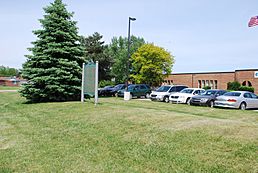Holcombe Site facts for kids
|
Holcombe Site
|
|

The historic marker is placed "near" the Holcombe Site
|
|
| Location | Intersection of Metropolitan Parkway and Dodge Park Road, Sterling Heights, Michigan |
|---|---|
| Area | 1 acre (0.40 ha) |
| NRHP reference No. | 71001023 |
Quick facts for kids Significant dates |
|
| Added to NRHP | April 16, 1971 |
The Holcombe Site, also known as Holcombe Beach, is a very old place where early people lived. It's an archaeological site in Sterling Heights, Michigan, USA. This site shows us how Paleo-Indians lived thousands of years ago. It was added to the National Register of Historic Places in 1971. It also became a Michigan State Historic Site in 1970.
Contents
Discovering the Ancient Holcombe Site
How the Site Was Found
In 1961, two people who loved history, Jerome DeVisscher and Edward J. Wahla, found clues at this spot. They discovered signs of a very old settlement. These clues showed that people lived here a long, long time ago.
Dating the Past with Science
Later, scientists used a method called radiocarbon dating on parts of old campfires found at the site. This method helps figure out how old things are. They learned that the Holcombe Site is about 11,000 years old! This means it was a home for Paleo-Indians.
Uncovering Ancient Tools
Archaeologists from the University of Michigan spent five years digging here. They found many interesting artifacts, which are old objects made by people. These finds helped us learn a lot about the people who lived there.
What Are Holcombe Points?
Among the tools found were special small, thin arrowheads. They had a unique groove, or "flute," down the middle. These were named "Holcombe points." Similar arrowheads have been found in other parts of Michigan and southern Ontario. Some have also been found in northern Ohio, Indiana, Wisconsin, and Minnesota.
Life at the Holcombe Site Long Ago
The Ancient Landscape
When people lived at the Holcombe Site, it was on the edge of a small glacial lake. This lake was formed by melting glaciers. It likely drained into a larger ancient lake called Lake Algonquin. The land around it was cold, like a tundra.
Hunting for Survival
Archaeologists found arrowheads, flint chips (small pieces of stone from making tools), and even bone fragments. These clues tell us that the Paleo-Indians hunted Barren-ground caribou. These caribou were a type of deer that could live in the cold, tundra-like conditions.
Changes Over Time
The discoveries at the Holcombe Site also show how the lives of these early people changed. As the climate slowly warmed up, the environment around them changed. This led to shifts in their culture and how they found food to survive.



